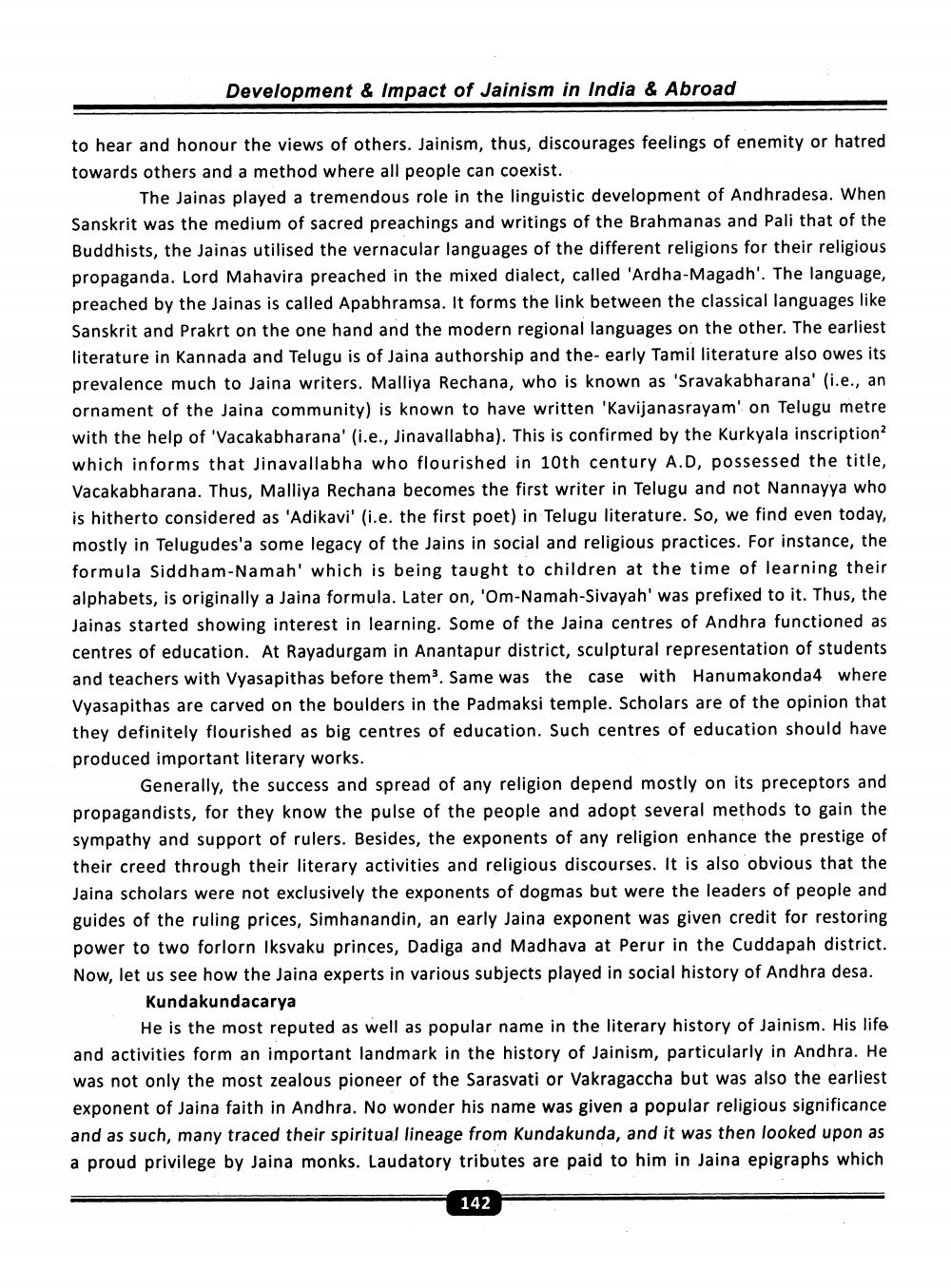________________
Development & Impact of Jainism in India & Abroad
to hear and honour the views of others. Jainism, thus, discourages feelings of enemity or hatred towards others and a method where all people can coexist.
The Jainas played a tremendous role in the linguistic development of Andhradesa. When Sanskrit was the medium of sacred preachings and writings of the Brahmanas and Pali that of the Buddhists, the Jainas utilised the vernacular languages of the different religions for their religious propaganda. Lord Mahavira preached in the mixed dialect, called 'Ardha-Magadh'. The language, preached by the Jainas is called Apabhramsa. It forms the link between the classical languages like Sanskrit and Prakrt on the one hand and the modern regional languages on the other. The earliest literature in Kannada and Telugu is of Jaina authorship and the early Tamil literature also owes its prevalence much to Jaina writers. Malliya Rechana, who is known as 'Sravakabharana' (i.e., an ornament of the Jaina community) is known to have written 'Kavijanasrayam' on Telugu metre with the help of 'Vacakabharana' (i.e., Jinavallabha). This is confirmed by the Kurkyala inscription? which informs that Jinavallabha who flourished in 10th century A.D, possessed the title, Vacakabharana. Thus, Malliya Rechana becomes the first writer in Telugu and not Nannayya who is hitherto considered as 'Adikavi' (i.e. the first poet) in Telugu literature. So, we find even today, mostly in Telugudes'a some legacy of the Jains in social and religious practices. For instance, the formula Siddham-Namah' which is being taught to children at the time of learning their alphabets, is originally a Jaina formula. Later on, 'Om-Namah-Sivayah' was prefixed to it. Thus, the Jainas started showing interest in learning. Some of the Jaina centres of Andhra functioned as centres of education. At Rayadurgam in Anantapur district, sculptural representation of students and teachers with Vyasapithas before them. Same was the case with Hanumakonda4 where Vyasapithas are carved on the boulders in the Padmaksi temple. Scholars are of the opinion that they definitely flourished as big centres of education. Such centres of education should have produced important literary works.
Generally, the success and spread of any religion depend mostly on its preceptors and propagandists, for they know the pulse of the people and adopt several methods to gain the sympathy and support of rulers. Besides, the exponents of any religion enhance the prestige of their creed through their literary activities and religious discourses. It is also obvious that the Jaina scholars were not exclusively the exponents of dogmas but were the leaders of people and guides of the ruling prices, Simhanandin, an early Jaina exponent was given credit for restoring power to two forlorn Iksvaku princes, Dadiga and Madhava at Perur in the Cuddapah district. Now, let us see how the Jaina experts in various subjects played in social history of Andhra desa.
Kundakundacarya
He is the most reputed as well as popular name in the literary history of Jainism. His life and activities form an important landmark in the history of Jainism, particularly in Andhra. He was not only the most zealous pioneer of the Sarasvati or Vakragaccha but was also the earliest exponent of Jaina faith in Andhra. No wonder his name was given a popular religious significance and as such, many traced their spiritual lineage from Kundakunda, and it was then looked upon as a proud privilege by Jaina monks. Laudatory tributes are paid to him in Jaina epigraphs which
142




